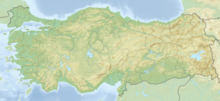Hisarçık rock inscription
Coordinates: 38 ° 38 ′ 4 ″ N , 35 ° 31 ′ 1 ″ E
The rock inscription from Hisarçık in southern Turkey is written in Luwian hieroglyphics and dates from the time of the late Hittite states . It is assigned to the Kingdom of Tabal and is believed to have been in the late 8th century BC. BC originated. In technical literature it is referred to as Hisarçık 2 .
location
The rock inscription is located in the area of the Erciyes Dağı volcano southeast of the town of Hisarçık in the Melikgazi district of the Turkish province of Kayseri . It was seen on a farm at the foot of the Top Tepesi hill. Due to the increasing urbanization and overbuilding of the area since at least the beginning of the 2000s, it can no longer be found today.
Research history
The inscription was discovered and described in 1901 by the German amateur archaeologist Waldemar Belck on a trip to Asia Minor. The Cornell expedition to Asia Minor and the Assyro-Babylonian Orient ( Cornell University ) from 1907 visited the site and published photos and a description. This was followed by visits and publications by John Garstang (1908), Ignace Gelb (1932), Piero Meriggi (1958) and John David Hawkins (1969), who included the text in his Corpus of Hieroglyphic Luwian Inscriptions , published in 2000 . Horst Ehringhaus , who attempted to document the inscription again in 2011 and 2012, could no longer find it.
description
The smooth rock face bearing the inscription is 1.17 meters wide and 0.65 meters high. It is divided in the middle by a gap. The carved text consists of two lines, the upper one to the left and the lower one to the right, separated by a line. The legibility of the hieroglyphic symbols is severely impaired by the advanced erosion. Hawkins sees in the text offerings to Mount Harhari, which is identical to the Erciyes Dağı, as well as possibly a mention of a king kurtis . Kurtis is also mentioned on a stele found in the area (Hisarçık 1, now in the Istanbul Archaeological Museum ). This ruler can possibly be equated with Kurti of (A) do (n) a , whom Sargon II mentions for the period from 718 to 713. This would lead to the epigraphic dating by Hawkins in the late 8th century BC. Chr. Fit.
literature
- John David Hawkins : Corpus of Hieroglyphic Luwian Inscriptions. Volume I: Inscriptions of the Iron Age. Part 2: text. Amuq, Aleppo, Hama, Tabal, Assur Letters, Miscellaneous, Seals, Indices. Part 3: Plates. (= Studies in Indo-European Language and Culture. Volume 8). de Gruyter, Berlin et al. 2000, ISBN 3-11-010864-X , pp. 496-497.
- Horst Ehringhaus : The end that was a beginning - rock reliefs and rock inscriptions of the Luwian states of Asia Minor from 12th to 8th/7 Century BC Chr. Nünnerich-Asmus, Mainz 2014, ISBN 978-3-943904-67-3 , pp. 75–81.
Web links
Individual evidence
- ↑ Waldemar Belck: Research trip in Asia Minor In: Negotiations of the Berlin Society for Anthropology, Ethnology and Prehistory 1901 pp. 452-522
- ^ Benson Brush Charles: Hittite Inscriptions ( Cornell Expedition to Asia Minor ). Ithaca / New York 1911, pp. 13-16.
- ↑ Dimensions according to Ehringhaus p. 76. The height of 0.37 meters given by Hawkins p. 496 can hardly be correct in relation to the width according to the illustration there, plate 277.
- ^ John David Hawkins: Corpus of Hieroglyphic Luwian Inscriptions. Vol. I: Inscriptions of the Iron Age. Part 2: text. Amuq, Aleppo, Hama, Tabal, Assur Letters, Miscellaneous, Seals, Indices. Part 3: Plates. (= Studies in Indo-European Language and Culture 8). de Gruyter, Berlin et al. 2000, ISBN 3-11-010864-X , pp. 478, 483.



